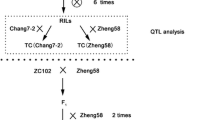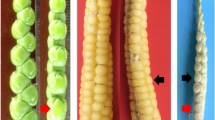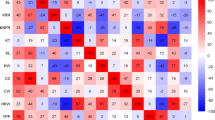Abstract
Plant height (PH) and ear height (EH) are important traits in maize (Zea mays L.) breeding. Previous research has indicated that these traits are influenced by quantitative trait loci (QTL). However, previous studies attempting to identify the genetic bases of PH and EH have ignored the possibility that cytoplasmic effects and cytonuclear interactions may influence these traits. The objectives of this study were to identify the cytonuclear epistatic QTL and to evaluate the contributions of cytoplasm and QTL × cytoplasm interactions to phenotypic variation of PH and EH. A reciprocal mating design was conducted to generate F2 mapping populations comprising 120 F2 plants from the direct cross (JB × Y53) and 120 F2 plants from the reciprocal cross (Y53 × JB). F2:3 mapping populations were further generated with 91 direct F2:3 families and 120 reciprocal F2:3 families (ten plants per family). The PH and EH of the above F2 and F2:3 mapping populations were evaluated in the same field at the same experimental station in 2007 and 2008. A genetic linkage map with 154 microsatellite markers was constructed, which covered 1,735.0 cM of the maize genome with an average marker spacing of 11.3 cM. A joint-analysis method incorporating the cytonuclear interaction mapping approach was proposed and performed to detect cytonuclear interacting QTL affecting PH and EH. We identified six cytonuclear epistatic QTL affecting PH and five affecting EH. The average phenotypic variance explained by the genetic components of the QTL × cytoplasm interaction for each QTL was 18 % for PH and 9 % for EH. In addition, we observed cytoplasmic effects contributing substantially to phenotypic variance, reaching 9 and 40 % of the phenotypic contributions to PH and EH, respectively.

Similar content being viewed by others
References
Allen JO (2005) Effect of teosinte cytoplasmic genomes on maize phenotype. Genetics 169:863–880
Beavis WD, Grant D (1991) A linkage map based on information from four F2 populations of maize (Zea mays L.). Theor Appl Genet 82:636–644
Chinnery PF (2003) Searching for nuclear-mitochondrial genes. Trends Genet 19:60–62
Frascaroli E, Cane MA, Landi P, Pea G, Gianfranceschi L, Villa M, Morgante M, Pe ME (2007) Classical genetic and quantitative trait loci analyses of heterosis in a maize hybrid between two elite inbred lines. Genetics 176:625–644
Helentjaris T, Slocum M, Wright S, Schaefer A, Nienhuis J (1986) Construction of genetic linkage maps in maize and tomato using restriction fragment length polymorphisms. Theor Appl Genet 72:761–769
Hu Z, Xu S (2009) PROC QTL-A SAS procedure for mapping quantitative trait loci. Int J Plant Genomics 2009:141234
Koester RP, Sisco PH, Stuber CW (1993) Identification of quantitative trait loci controlling days to flowering and plant height in two near isogenic lines of maize. Crop Sci 33:1209–1216
Kosambi DD (1944) The estimation of map distances from recombination values. Ann Eugen 12:172–175
Levin DA (2003) The cytoplasmic factor in plant speciation. Syst Bot 28:5–11
Lima M, de Souza C, Bento D, de Souza A, Carlini-Garcia L (2006) Mapping QTL for grain yield and plant traits in a tropical maize population. Mol Breed 17:227–239
Malosetti M, Ribaut J, Vargas M, Crossa J, van Eeuwijk F (2008) A multi-trait multi-environment QTL mixed model with an application to drought and nitrogen stress trials in maize (Zea mays L.). Euphytica 161:241–257
McCouch SR, Cho YG, Yano PE, Blinstrub M, Morishima H, Kinoshita T (1997) Report on QTL nomenclature. Rice Genet Newsl 14:11–13
Meng FR, Ni ZF, Wu LM, Xie XD, Wang ZG, Sun QX (2005) Differential gene expression between reciprocal cross fertilized kernels and their parents during the early stages of seed development in wheat. Acta Agron Sin 31(1):119–123
Nichols KM, Broman KW, Sundin K, Young JM, Wheeler PA, Thorgaard GH (2007) Quantitative trait loci x maternal cytoplasmic environment interaction for development rate in Oncorhynchus mykiss. Genetics 175:335–347
Piepho HP (2001) A quick method for computing approximate thresholds for quantitative trait loci detection. Genetics 157:425–432
Rand DM, Haney RA, Fry AJ (2004) Cytonuclear coevolution: the genomics of cooperation. Trends Ecol Evol 19:645–653
Rand DM, Fry A, Sheldahl L (2006) Nuclear-mitochondrial epistasis and drosophila aging: introgression of Drosophila simulans mtDNA modifies longevity in D. melanogaster nuclear backgrounds. Genetics 172:329–341
Rhode JM, Cruzan MB (2005) Contributions of heterosis and epistasis to hybrid fitness. Am Nat 166:E124–E139
Rogers SO, Bendich AJ (1988) Extraction of DNA from plant tissues. Plant Mol Biol Man A6:1–10
Roubertoux PL, Sluyter F, Carlier M, Marcet B, Maarouf-Veray F, Cherif C, Marican C, Arrechi P, Godin F, Jamon M, Verrier B, Cohen-Salmon C (2003) Mitochondrial DNA modifies cognition in interaction with the nuclear genome and age in mice. Nat Genet 35:65–69
Shi Y-S, Yu Y-T, Song Y-C, Liu Z–Z, Li Y, Wang T-Y (2010) Identification of a QTL for plant height in a new dwarf germplasm of maize. Acta Agron Sin 36:256–260
Sibov ST, De Souza Jr CL, Garcia AAF, Silva AR, Garcia AF, Mangolin CA, Benchimol LL, De Souza AP (2003) Molecular mapping in tropical maize (Zea mays L.) using microsatellite markers. 2. Quantitative trait loci (QTL) for grain yield, plant heigth, ear height and grain moisture. Hereditas 139:107–115
Tang Z, Wang X, Hu Z, Yang Z, Xu C (2007) Genetic dissection of cytonuclear epistasis in line crosses. Genetics 177:669–672
Tao D, Hu F, Yang J, Yang G, Yang Y, Xu P, Li J, Ye C, Dai L (2004) Cytoplasm and cytoplasm-nucleus interactions affect agronomic traits in japonica rice. Euphytica 135:129–134
Thornsberry JM, Goodman MM, Doebley J, Kresovich S, Nielsen D, Buckler ESt (2001) Dwarf8 polymorphisms associate with variation in flowering time. Nat Genet 28:286–289
Van Ooijen JW, Vorrips RE (2001) JoinMap® Version 3.0, Software for the calculation of genetic linkage map. Plant Research International. Wageningen, The Netherlands
Wang S, Basten CJ, Zeng Z-B (2007) Windows QTL Cartographer 2.5. Department of Statistics, North Carolina State University, Raleigh, NC
Xu S (2008) Quantitative trait locus mapping can benefit from segregation distortion. Genetics 180:2201–2208
Xu Y, Li H-N, Li G-J, Wang X, Cheng L-G, Zhang Y-M (2011) Mapping quantitative trait loci for seed size traits in soybean (Glycine max L. Merr.). Theor Appl Genet 122:581–594
Yan J, Tang H, Huang Y, Shi Y, Li J, Zheng Y (2003a) Dynamic analysis of QTL for plant height at different developmental stages in maize (Zea mays L.). Chin Sci Bull 48:2601–2607
Yan J, Tang H, Huang Y, Shi Y, Zheng Y, Li J (2003b) QTL analysis for plant height with molecular markers in maize. Agric Sci Chin 2:1069–1075
Yang XJ, Lu M, Zhang SH, Zhou F, Qu YY, Xie CX (2008) QTL mapping of plant height and ear position in maize (Zea mays L.). Hereditas 30:1477–1486
Zeng ZB (1994) Precision mapping of quantitative trait loci. Genetics 136:1457–1468
Zeyl C, Andreson B, Weninck E (2005) Nuclear-mitochondrial epistasis for fitness in Saccharomyces cerevisiae. Evol Int J Org Evol 59:910–914
Zhang YM, Xu S (2004) Mapping quantitative trait loci in F2 incorporating phenotypes of F3 progeny. Genetics 166:1981–1993
Acknowledgments
We thank the editor and referees for their constructive comments on the manuscript. This work was supported by grants from the National Basic Research Program of China (2011CB100100), the Priority Academic Program Development of Jiangsu Higher Education Institutions, the National Natural Science Foundation of China (30971846, 31171187) and the Vital Project of Natural Science of Universities in Jiangsu Province (09KJA210002) (to C. Xu); and the National Natural Science Foundation of China (31100882) (to Z. Tang). The funders had no role in study design, data collection and analysis, decision to publish, or preparation of the manuscript.
Author information
Authors and Affiliations
Corresponding author
Electronic supplementary material
Below is the link to the electronic supplementary material.
Rights and permissions
About this article
Cite this article
Tang, Z., Yang, Z., Hu, Z. et al. Cytonuclear epistatic quantitative trait locus mapping for plant height and ear height in maize. Mol Breeding 31, 1–14 (2013). https://doi.org/10.1007/s11032-012-9762-3
Received:
Accepted:
Published:
Issue Date:
DOI: https://doi.org/10.1007/s11032-012-9762-3




